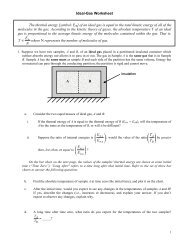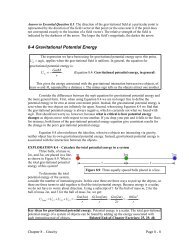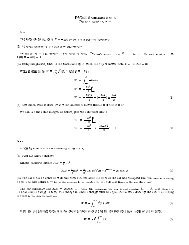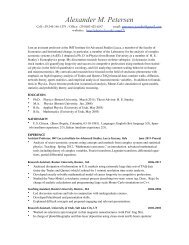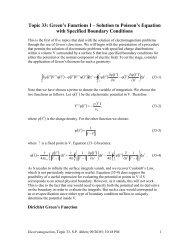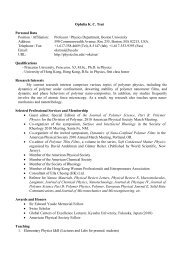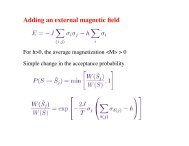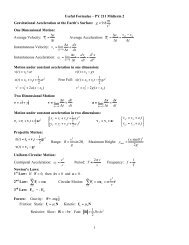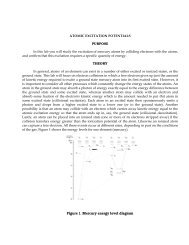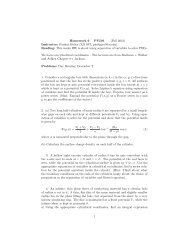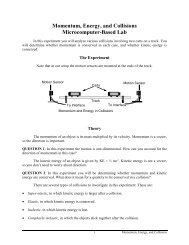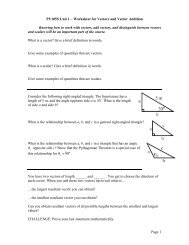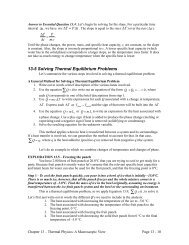Crystal Structure 1 3.1 Some Basic Concepts of Crystal Structure ...
Crystal Structure 1 3.1 Some Basic Concepts of Crystal Structure ...
Crystal Structure 1 3.1 Some Basic Concepts of Crystal Structure ...
You also want an ePaper? Increase the reach of your titles
YUMPU automatically turns print PDFs into web optimized ePapers that Google loves.
<strong>Crystal</strong> <strong>Structure</strong><br />
<strong>Basic</strong> <strong>Concepts</strong><br />
<strong>3.1</strong> <strong>Some</strong> <strong>Basic</strong> <strong>Concepts</strong> <strong>of</strong> <strong>Crystal</strong> <strong>Structure</strong>: Basis and Lattice<br />
A crystal lattice can always be constructed by the repetition <strong>of</strong> a fundamental set <strong>of</strong><br />
translational vectors in real space a, b, and c, i.e., any point in the lattice can be written<br />
as:<br />
r = n 1 a + n 2 b + n 3 c. (<strong>3.1</strong>)<br />
Such a lattice is called a Bravais lattice. The translational vectors, a, b, and c are the<br />
primitive vectors. Note that the choice for the set <strong>of</strong> primitive vectors for any given<br />
Bravais lattice is not unique.<br />
There are three common cubic Bravais lattices: Simple cubic (sc), body-centered<br />
cubic (bcc), and face-centered cubic (fcc).<br />
Fig. <strong>3.1</strong> (from Kittle) The cubic space lattices. The cells shown are the conventional cells.<br />
The commonly adopted primitive vectors <strong>of</strong> these cubic lattices are (see Fig. 3.2):<br />
<br />
<br />
Simple Cubic<br />
<br />
a1<br />
ax<br />
a<br />
ayˆ<br />
2<br />
a<br />
azˆ<br />
3 <br />
Body Centered Cubic<br />
a <br />
a ( ˆ<br />
1<br />
x y zˆ)<br />
2<br />
a <br />
a ( ˆ<br />
2<br />
x<br />
y zˆ)<br />
2<br />
a <br />
a ( ˆ<br />
3<br />
x y zˆ)<br />
2<br />
(3.2)<br />
(3.3)<br />
1
<strong>Crystal</strong> <strong>Structure</strong><br />
<strong>Basic</strong> <strong>Concepts</strong><br />
<br />
Face Centered Cubic<br />
<br />
a1 a(<br />
x yˆ)<br />
<br />
a ( ˆ<br />
2<br />
a y zˆ)<br />
<br />
a a(<br />
x ˆ)<br />
3<br />
z<br />
(3.4)<br />
(a)<br />
(b)<br />
Fig. 3.2<br />
Coordination number: The points in a Bravais lattice that are closest to a given point are<br />
called its nearest neighbors. Because <strong>of</strong> the periodic nature <strong>of</strong> a Bravais lattice, each point<br />
has the same number <strong>of</strong> nearest neighbors. This number is called the coordination<br />
number. For example, a sc lattice has coordination number 6; a bcc lattice, 8; a fcc lattice,<br />
12.<br />
Primitive unit cell: A volume in space, when translated through all the lattice vectors in a<br />
Bravais lattice, fills the entire space without voids or overlapping itself, is a primitive unit<br />
cell (see Figs. 3.3 and 3.4). Like primitive vectors, the choice <strong>of</strong> primitive unit cell is not<br />
unique (Fig. 3.3). It can be shown that each primitive unit cell contains precisely one<br />
lattice point unless it is so chosen that there are lattice points lying on its surface. It then<br />
follows that the volume <strong>of</strong> all primitive cells <strong>of</strong> a given Bravais lattice is the same.<br />
2
<strong>Crystal</strong> <strong>Structure</strong><br />
<strong>Basic</strong> <strong>Concepts</strong><br />
Fig. 3.3 (from A&M) Several possible choices <strong>of</strong> primitive cell for the<br />
same two-dimensional Bravais lattice.<br />
(a)<br />
(b)<br />
Fig. 3.4 (from A&M) Primitive unit cell for the choice <strong>of</strong> primitive vectors specified in Eqs. 3.3 and 3.4<br />
for, respectively, an (a) fcc and (b) a bcc Bravais lattice.<br />
Unit cell and lattice constants: A unit cell is a volume, when translated through some<br />
subset <strong>of</strong> the vectors <strong>of</strong> a Bravais lattice, can fill up the whole space without voids or<br />
overlapping with itself. The conventional unit cell chosen is usually bigger than the<br />
primitive cell in favor <strong>of</strong> preserving the symmetry <strong>of</strong> the Bravais lattice. For example, the<br />
primitive cells shown in Figs. 3.4(a) and (b) for respectively the fcc and bbc Bravais<br />
lattice are parallelipipeds that do not bear the cubic symmetry <strong>of</strong> their own lattice. The<br />
conventional unit cell <strong>of</strong> the respective lattice is the cubic cell shown in the same figure.<br />
Note that the volume <strong>of</strong> the conventional unit cell is four times that <strong>of</strong> the primitive unit<br />
cell for fcc, and two times for bcc. The lattice constant, a, <strong>of</strong> a cubic lattice (sc, bcc and<br />
fcc) refers to the length <strong>of</strong> the side <strong>of</strong> the cubic unit cell.<br />
3
<strong>Crystal</strong> <strong>Structure</strong><br />
<strong>Basic</strong> <strong>Concepts</strong><br />
Wigner-Seitz primitive cell: It turns out one can always choose a primitive unit cell with<br />
the full symmetry <strong>of</strong> the Bravais lattice. The most popular choice is the Wigner-Seitz cell.<br />
By construction, there is only one Wigner-Seitz cell about a lattice point. To construct a<br />
Wigner-Seitz cell, one draws lines connecting one given lattice point to all its nearby<br />
points in the lattice, bisects each line with a plane, and takes the smallest polyhedron<br />
containing the point bounded by these planes. Fig. 3.5 illustrates the Wigner-Seitz cell <strong>of</strong><br />
a two-dimensional Bravais lattice. Figs. 3.6 and 3.7 illustrate the Wigner-Seitz cell for the<br />
bbc and fcc lattice, respectively.<br />
Fig. 3.5 (from (A&M) The Wigner-Seitz cell <strong>of</strong><br />
a two-dimensional Bravais lattice.<br />
Fig. 3.6 (from A&M) The Wigner-Seitz cell for<br />
the bcc Bravais lattice (a “truncated<br />
octahedron”). The surrounding cube is a<br />
conventional bcc cell with a lattice point at its<br />
center and on each vertex. The hexagonal faces<br />
bisect the lines joining the central point to the<br />
points on the vertices (drawn as solid lines).<br />
The square faces bisect the lines joining the<br />
central point to the central points in each <strong>of</strong> the<br />
six neighboring cubic cells (not drawn).<br />
Fig. 3.7 (from A&M) The Wigner-Seitz cell for<br />
the fcc Bravais lattice (a “rhombic<br />
dodecahedron”). The surrounding cube is not<br />
the conventional bcc cell <strong>of</strong> Fig. 3.4(a), but one<br />
in which lattice points are at the center <strong>of</strong> the<br />
cube and at the center <strong>of</strong> the 12 edges. Each <strong>of</strong><br />
the 12 faces (all identical in shape and size) is<br />
perpendicular to a line joining the central point<br />
to a point on the center <strong>of</strong> an edge.<br />
4
<strong>Crystal</strong> <strong>Structure</strong><br />
<strong>Basic</strong> <strong>Concepts</strong><br />
<strong>Crystal</strong> <strong>Structure</strong><br />
In the above, we have discussed the concept <strong>of</strong> crystal lattice. To complete a crystal<br />
structure, one needs to attach the basis (a fixed group <strong>of</strong> atoms) to each lattice point, i.e.,<br />
Bravais Lattice + Basis = <strong>Crystal</strong> <strong>Structure</strong><br />
Fig. 3.8 (From Kittel) The crystal<br />
structure is formed by the addition <strong>of</strong> the<br />
basis (b) to the lattice points <strong>of</strong> the lattice<br />
(a). By looking at (c), you can recognize<br />
the basis and then you can abstract the<br />
space lattice. It does not matter where the<br />
basis is put in relation to a lattice point.<br />
<strong>Some</strong> examples:<br />
(1) Diamond structure<br />
Fig. 3.9 (From A&M) Conventional cubic cell <strong>of</strong><br />
the diamond lattice. This structure consists <strong>of</strong> two<br />
interpenetrating fcc lattices, displaced along the<br />
body diagonal <strong>of</strong> the cubic cell by ¼ the length <strong>of</strong><br />
the diagonal. It can be regarded as a fcc lattice<br />
with the two-point basis at (000) and 1/4(111).<br />
Note that the diamond structure is not a Bravais<br />
lattice.<br />
5
<strong>Crystal</strong> <strong>Structure</strong><br />
<strong>Basic</strong> <strong>Concepts</strong><br />
(2) Sodium chloride structure<br />
Fig. <strong>3.1</strong>0 (From Kittel) The sodium chloride<br />
structure is produced by arranging Na + and Cl <br />
ions alternatively at the lattice points <strong>of</strong> a sc<br />
lattice. In the crystal each ion is surrounded by 6<br />
nearest neighbors <strong>of</strong> the opposite charge. The<br />
space lattice is fcc, and the basis has one Na + at<br />
½(111) and Cl at (000). The figure shows one<br />
conventional unit cell. The ionic diameters here<br />
are reduced in relation to the cell in order to<br />
clarify the spatial arrangement.<br />
(3) Hexagonal close-packed (hcp) structure<br />
A hexagonal closed-packed structure is built upon two simple hexagonal Bravais<br />
lattices. Figure <strong>3.1</strong>1 shows a simple hexagonal Bravais lattice. Figure <strong>3.1</strong>2 shows the<br />
structure <strong>of</strong> a hcp, and how it is constructed from two simple hexagonal structures.<br />
Fig. <strong>3.1</strong>1 (From A&M) A simple hexagonal Bravais lattice (a) in 3-dimensions (b) in 2-dimensions.<br />
6
<strong>Crystal</strong> <strong>Structure</strong><br />
Bragg Diffraction & Reciprocal Lattice Vectors<br />
Fig. <strong>3.1</strong>2 (From A&M) The hcp structure. It can<br />
be viewed as two interpenetrating simple<br />
hexagonal lattices, displaced vertically by a<br />
distance c/2 along the common c-axis, and<br />
displaced horizontally so that the points <strong>of</strong> one lie<br />
directly above the centers <strong>of</strong> the triangles formed<br />
by the points <strong>of</strong> the other.<br />
3.2 Bragg Diffraction and Reciprocal Lattice Vectors<br />
Bragg Diffraction (Simple Picture)<br />
Periodic lattice planes<br />
Fig. <strong>3.1</strong>3 Schematic diagram illustrating the condition for Bragg diffraction.<br />
Bragg diffraction condition: <br />
2d sin = n<br />
<br />
where n = 1, 2, 3, … (3.5)<br />
7
<strong>Crystal</strong> <strong>Structure</strong><br />
Bragg Diffraction and Reciprocal Lattice Vectors<br />
An incident beam <strong>of</strong> radiation or particles is diffracted from a crystal only if the Bragg<br />
diffraction condition (3.5) is satisfied. We can view it as the condition where<br />
constructive interference takes place between the diffracted radiation or particles from the<br />
adjacent planes. Since the lattice constant <strong>of</strong> crystals is <strong>of</strong> the order <strong>of</strong> 2 to 3 Å, for easily<br />
measurable (such as ~1 to 10 o ) at the first order Bragg diffraction, it is desirable for the<br />
wavelength <strong>of</strong> the beam, ~ 0.1 to 1Å. These values correspond to the wavelength <strong>of</strong> x-<br />
rays and 10 - 100 keV electrons. The latter constitutes the basics <strong>of</strong> transmission electron<br />
microscopes.<br />
Miller Indices<br />
Miller indices are convenient labels <strong>of</strong> crystal planes. The following are steps to<br />
determine the Miller indices <strong>of</strong> a crystal plane:<br />
(1) Determine the intercepts l 1 , l 2 and l 3 <strong>of</strong> the plane on the three translation axes in<br />
units <strong>of</strong> the translation vectors.<br />
(2) Take the reciprocal <strong>of</strong> the intercepts (1/l 1 , 1/l 2 1/l 3 ) and multiple by the smallest<br />
constant that makes them integers (h, k, l).<br />
Miller Indices can also be used to label the group <strong>of</strong> equivalent planes {h, k, l}.<br />
Examples:<br />
(2, 3, 3)<br />
Fig. <strong>3.1</strong>4<br />
8
<strong>Crystal</strong> <strong>Structure</strong><br />
Bragg Diffraction and Reciprocal Lattice Vectors<br />
Fig. <strong>3.1</strong>5<br />
Reciprocal Vectors<br />
The reciprocal lattice <strong>of</strong> a Bravais lattice constructed by the set <strong>of</strong> primitive vectors, a, b<br />
and c is one that has primitive vectors given by:<br />
<br />
<br />
<br />
b c <br />
<br />
c a <br />
<br />
a b<br />
A 2 B 2 C <br />
a b c<br />
a b c<br />
2 <br />
a b c<br />
(3.6)<br />
Examples:<br />
(1) Reciprocal lattice to simple cubic lattice<br />
For sc lattice, we may choose the following set <strong>of</strong> primitive vectors:<br />
<br />
a aˆ,<br />
a aˆ,<br />
a aˆ,<br />
1<br />
x<br />
2<br />
y<br />
3<br />
z<br />
We may then determine the reciprocal lattice vectors b 1 , b 2 and b 3 using eqn. 3.6:<br />
<br />
<br />
a2<br />
a3<br />
2<br />
b 2 xˆ<br />
1<br />
.<br />
3<br />
a a<br />
Similarly,<br />
2<br />
2<br />
b yˆ<br />
2<br />
and b3<br />
zˆ<br />
a<br />
a<br />
9
<strong>Crystal</strong> <strong>Structure</strong><br />
Bragg Diffraction and Reciprocal Lattice Vectors<br />
10
<strong>Crystal</strong> <strong>Structure</strong><br />
Next we discuss the physical meaning <strong>of</strong> reciprocal lattice vectors as defined in eqn. 3.6.<br />
Consider the primitive vectors, a, b and c <strong>of</strong> a lattice as depicted below.<br />
We first focus on the plane (100) as marked in the figure. One may observe that the area<br />
<strong>of</strong> this plane is |a b| and the cross product a b is normal to the plane and directed<br />
away from the origin. In addition, the volume <strong>of</strong> the parallelepiped generated by a, b and<br />
c, which we label by V abc is a (b c) (= b (c a) = c (a b)). It follows that the<br />
distance between this plane the one next and parallel to it is:<br />
<br />
Vabc<br />
a b c<br />
d100 .<br />
b c b c<br />
(3.7)<br />
Therefore, the reciprocal lattice vector, A, as defined in eqn. 3.6 can be rewritten as:<br />
<br />
<br />
<br />
b c 1<br />
A 2<br />
2<br />
nˆ<br />
100<br />
d<br />
(3.8)<br />
a b c<br />
100<br />
where n 100 is the unit vector normal to (100) (and directed away from the origin.) By<br />
repeating the argument for the other two planes, i.e., (010) and (001), we have:<br />
<br />
B <br />
<br />
C <br />
1<br />
2<br />
nˆ<br />
d<br />
010<br />
1<br />
2<br />
nˆ<br />
d<br />
001<br />
010<br />
001<br />
(3.9)<br />
where n 010 and n 001 is the unit normal to (010) and (001), respectively.<br />
11
<strong>Crystal</strong> <strong>Structure</strong><br />
The above result can be generalized to an arbitrary reciprocal lattice vector, G = hA + kB<br />
+ lC. In other words, G is related to the plane (h k l) by the following relations:<br />
(1) G is normal to the plane (h k l).<br />
(2) The distance d hkl between adjacent planes with the Miller indexes (h k l) is given<br />
by 2/|G|.<br />
Pro<strong>of</strong>:<br />
(1) By definition, a plane (h k l) intersects the<br />
crystallographic axes along a, b and c at the points<br />
l 1 a, l 2 b and l 3 c, respectively, where<br />
l1 : l2<br />
: l3<br />
<br />
1 1 1<br />
: :<br />
h k l<br />
where l 1 , l 2 and l 3 are integers. Now, all planes whose<br />
intercepts fulfill the above relation are parallel.<br />
Therefore, it suffices to prove that the one plane with intercepts 1/h, 1/k and 1/l is<br />
perpendicular to G. One may observe that any vector on this plane can be expressed as a<br />
linear combination <strong>of</strong> the vectors (1/h)a – (1/k)b, (1/k)b – (1/l)c and (1/l)c – (1/h)a. It<br />
follows that if G is perpendicular to all <strong>of</strong> these three vectors, G must be parallel to (h k<br />
l). As shown below, this is indeed the case.<br />
Note that this pro<strong>of</strong> works only if none <strong>of</strong> h, k or l is zero. Suppose l = 0. Then the plane<br />
to be considered is spanned by (1/h)a – (1/k)b and c. It is straightforward to show that hA<br />
+ kB is perpendicular to these two vectors. In the case where two <strong>of</strong> the Miller indices<br />
are zero, say k = l = 0, G = A. We have shown above that it is perpendicular to the (1 0 0)<br />
plane (eqn. 3.8).<br />
12
<strong>Crystal</strong> <strong>Structure</strong><br />
Bragg Diffraction and Reciprocal Lattice Vectors<br />
We now return to Bragg diffraction and see how it is related to the reciprocal lattice<br />
vectors. Recall eqn. (3.5) for the Bragg diffraction condition:<br />
2d sin = n<br />
<br />
where n = 1, 2, 3, …<br />
Experimentally, it is found that Bragg diffraction is elastic, i.e., the energy <strong>of</strong> the<br />
incoming beam is equal to that <strong>of</strong> the outgoing beam. For x-ray, E = ħ = ħ|k|c, where c<br />
is speed <strong>of</strong> light and k is the wavevector <strong>of</strong> the incident x-ray. Elastic scattering means<br />
that |k| =| k’|, where k’ is the wavector <strong>of</strong> the outgoing x-ray beam. Given this, one may<br />
construct the following vector diagram:<br />
13
<strong>Crystal</strong> <strong>Structure</strong><br />
The vector, k = k’ – k is the change in wavevector and proportional to the change in<br />
momentum <strong>of</strong> the x-ray upon diffraction. At the first order diffraction,<br />
2d sin = k<br />
2k sind = |G|, (<strong>3.1</strong>0)<br />
where G is the reciprocal lattice vector associated with the diffraction planes. It is also<br />
evident from the above figure that k is perpendicular to the diffraction planes. In order<br />
words, k is parallel to G. Combining this with eqn. (<strong>3.1</strong>0) we have:<br />
k = G<br />
(<strong>3.1</strong>0b)<br />
Eqn. 3.7 states the important fact that a (photon or particle) beam diffracted by the Bragg<br />
plane (h k l) always suffers a change <strong>of</strong> momentum equals G = hA + kB + lC in both<br />
magnitude and direction. With this, we may discuss the Ewald construction.<br />
Ewald Construction<br />
Ewald construction provides a convenient graphical method to look for the Bragg<br />
diffraction condition for a Bravais lattice. The procedure is as the following: We draw in<br />
reciprocal space a sphere centerd on the tip <strong>of</strong> the incident wavevector k (drawn from the<br />
origin) <strong>of</strong> radius k. This is the Ewald sphere. A diffracted beam will form if this sphere<br />
intersects any lattice point, K, in the reciprocal space. The direction <strong>of</strong> the diffracted<br />
beam is the direction <strong>of</strong> k’ ( k K).<br />
14
<strong>Crystal</strong> <strong>Structure</strong><br />
Fig. <strong>3.1</strong>8<br />
(from A&M)<br />
The Ewald construction may help us understand the principle <strong>of</strong> some common x-ray<br />
diffraction techniques used for the determination <strong>of</strong> crystal structures.<br />
Laue Diffraction Method<br />
This method is widely used for quick determination <strong>of</strong> the orientation <strong>of</strong> a crystal<br />
surface. The experimental setup is shown in Fig. <strong>3.1</strong>9. During the measurement, the<br />
sample is kept stationary, and is irradiated by a well-collimated x-ray beam with a broad<br />
spectral distribution. Both the forward and backward scattered rays are recorded on<br />
photographic films. The resulting pattern is a set <strong>of</strong> points (which are the diffraction<br />
spots), each coming from one set <strong>of</strong> crystallographic planes. The Ewald construction <strong>of</strong><br />
Fig. 3.21 illustrates the principle.<br />
Fig. <strong>3.1</strong>9<br />
15
<strong>Crystal</strong> <strong>Structure</strong><br />
Fig. 3.20 Laue pattern <strong>of</strong> a Si crystal in approximately the [100] direction.<br />
Fig. 3.21 The Ewald construction for the Laue<br />
method. The crystal and incident x-ray direction are<br />
fixed, and a continuous range <strong>of</strong> wavelengths,<br />
corresponding to wavevectors between k 0 and k 1 in<br />
magnitude is present. The Ewald spheres for all<br />
incident wavevectors fill the shaded region between<br />
the sphere centered on the tip <strong>of</strong> the vector k 0 and that<br />
centered on the tip k 0 . Bragg peaks will be observed<br />
corresponding to all reciprocal lattice points lying<br />
within the shaded region. (For simplicity in<br />
illustration, the incident direction has been taken to lie<br />
in a lattice plane, and only reciprocal lattice points<br />
lying in that plane are shown. (from A&M)<br />
16
<strong>Crystal</strong> <strong>Structure</strong><br />
Rotating <strong>Crystal</strong> Method<br />
This method uses a monochromatic beam <strong>of</strong> x-ray from a source that is fixed. The<br />
incident angle, , is variable by rotating the crystal orientation. (Note that is the angle<br />
between the incident x-ray and the crystal plane, not the sample surface (Fig. 3.23)) The<br />
detector is moved (by rotating the detector arm) to intercept the diffracted beam. Once<br />
the diffracted beam is found, is determined to be a half <strong>of</strong> the angle between the<br />
incident x-ray and the detector orientation, in accordance to the Bragg diffraction law.<br />
The single crystal is rotated by a precision goniometer to bring sets <strong>of</strong> atomic planes into<br />
positions for the Bragg diffraction during the measurement. The axis <strong>of</strong> rotation <strong>of</strong> the<br />
detector arm is perpendicular to both the incident and reflected beams. A diffraction spot<br />
is detected when a set <strong>of</strong> crystal planes with the appropriate inter-planar separation, d,<br />
satisfies the Bragg condition. The Ewald construction <strong>of</strong> Fig. 3.23 illustrates the principle<br />
<strong>of</strong> operation.<br />
To detector<br />
(rotatable)<br />
<br />
collimator<br />
<br />
2<br />
collimator<br />
Sample (rotatable)<br />
Fig. 3.22 Schematic diagram for the setup <strong>of</strong> the rotating crystal method.<br />
Fig. 3.23 The Ewald construction for the<br />
rotating-crystal method. For simplicity a case is<br />
shown in which the incident wavevector lies in a<br />
lattice plane. The concentric circles are the orbits<br />
swept out under the rotation by the reciprocal<br />
lattice vectors lying in the plane perpendicular to<br />
the axis containing k. Each intersection <strong>of</strong> such a<br />
circle with the Ewald sphere gives the<br />
wavevector <strong>of</strong> a Bragg reflected ray.<br />
(Additional) Bragg reflected wavevectors<br />
associated with reciprocal lattice vectors in other<br />
planes are not shown. (From A&M)<br />
17
<strong>Crystal</strong> <strong>Structure</strong><br />
Powder Diffraction<br />
In this method, the specimen is in a powder form hence contains a large number <strong>of</strong><br />
crystallites in random orientation. The x-ray used is monochromatic. Fig. 3.24 shows the<br />
schematic diagram <strong>of</strong> the setup and a powder diffraction pattern from ZnO. A set <strong>of</strong><br />
atomic planes with spacing d will give rise to a diffracted beam at an angle 2 (with<br />
respect to the incoming direction <strong>of</strong> the incident x-ray) according to the Bragg law. Since<br />
the orientation <strong>of</strong> the crystallites is random, the diffracted beam can at any azimuthal<br />
direction. The diffracted beams will spread around the surface <strong>of</strong> a cone with the apex at<br />
the specimen.<br />
Bragg Diffraction and Reciprocal Lattice Vectors<br />
Fig. 3.24 Schematic diagram <strong>of</strong> the setup for the powder diffraction method, and a powder pattern<br />
obtained from a ZnO sample.<br />
18
<strong>Crystal</strong> <strong>Structure</strong><br />
Fig. 3.25 The Ewald construction for the powder method. (a) The Ewald sphere is the smaller sphere. It is<br />
centered on the tip <strong>of</strong> the incident wavevector k with radius k, so that the origin 0 is on its surface. The<br />
larger sphere is centered on the origin and has a radius K. The two spheres intersect in a circle<br />
(foreshortened to an ellipse). Bragg reflections will occur for any wavevector k’ connecting any point on<br />
the circle <strong>of</strong> intersection to the tip <strong>of</strong> the vector k. The scattered rays therefore lie on the cone that opens in<br />
the direction opposite to k. (b) A plane section <strong>of</strong> (a), containing the incident wavevector. The triangle is<br />
isosceles, and thus K = 2ksin(/2).<br />
19
<strong>Crystal</strong> <strong>Structure</strong><br />
3.3 Kinematic Theory <strong>of</strong> Scattering<br />
r<br />
dV<br />
<br />
k<br />
k’<br />
Incident beam<br />
e ik·r<br />
kr<br />
|k|<br />
k’r<br />
|k’|<br />
Outgoing beam<br />
e ik’·r<br />
r<br />
k<br />
k’<br />
Fig. 3.26<br />
(from Kittel)<br />
The Bragg law only provides a condition for diffraction to occur. We need a deeper<br />
analysis to determine the scattering intensity from the basis <strong>of</strong> atoms.<br />
Consider an incoming x-ray with wavevector k. We want to calculate the<br />
scattering intensity in the direction along k’ due to a crystal (Fig. 3.26). First, we notice<br />
that waves scattered from different points <strong>of</strong> the specimen emerge with different path<br />
lengths from the wave scattered from the origin. For the wave scattered from a point at r,<br />
the path length difference between this emergent wave and that from the origin is<br />
(/2)(kk’)r. This leads to an extra phase factor <strong>of</strong> exp[i(kk’)r] in the wave scattered<br />
from point r compared to that scattered from the origin. Since the amplitude <strong>of</strong> the wave<br />
scattered from a volume element is proportional to the local electron concentration, n(r),<br />
the total amplitude <strong>of</strong> the scattered wave in the direction <strong>of</strong> k’ is proportional to the<br />
integral over the crystal <strong>of</strong> n(r)dV times the phase factor exp[i(kk’)r]. In other words,<br />
the amplitude <strong>of</strong> the electric or magnetic field vectors in the scattered electromagnetic<br />
wave is proportional to the following integral which defines the scattering amplitude, F:<br />
F = dV n(r) exp[i(kk’)r] = dV n(r) exp[ikr], (<strong>3.1</strong>1)<br />
where k = k’ k (<strong>3.1</strong>2)<br />
20
<strong>Crystal</strong> <strong>Structure</strong><br />
To evaluate the integral in eqn. <strong>3.1</strong>1, we will exploit the fact that n(r) is periodic, i.e.<br />
invariant under translation along any lattice vectors (which must be a linear combinations<br />
<strong>of</strong> the Bravais primitive vectors, a, b, and c.) Under this condition, the Fourier expansion<br />
<strong>of</strong> n(r) will be:<br />
G must be such that<br />
<br />
<br />
n( r ) n exp( iG r ) where (<strong>3.1</strong>3)<br />
<br />
G<br />
G<br />
n(r + ma + nb + pc) = n(r) for integers m, n, p. (<strong>3.1</strong>4)<br />
Here, n G is given by the Fourier transformation <strong>of</strong> n(r):<br />
n G = (1/V) dV n(r) exp[iGr] (<strong>3.1</strong>5)<br />
Eqn. <strong>3.1</strong>5 can be shown to be consistent with eqn. <strong>3.1</strong>3. We will now show that G must<br />
be a reciprocal lattice vector, i.e.<br />
G = jA + kB + lC (<strong>3.1</strong>6)<br />
where j, k, l are integers, and A, B, C are as defined in eqn. 3.6. Substitute eqn. <strong>3.1</strong>4 in<br />
eqn. <strong>3.1</strong>6, we have:<br />
<br />
<br />
<br />
n( r ) n exp( iG r ) n exp( iG r )exp[ iG ( ma nb pc)]<br />
n(<br />
r ma nb pc)<br />
<br />
<br />
G<br />
G<br />
Eqn. <strong>3.1</strong>7 is valid only if:<br />
<br />
<br />
G<br />
G<br />
(<strong>3.1</strong>7)<br />
G(ma + nb + pc) = 2M<br />
<br />
where M is an integer. Let’s write G as a linear combination <strong>of</strong> A, B, and C, as in eqn.<br />
<strong>3.1</strong>6, but putting no restriction on j, k, l. If we find in the end that j, k, l have to be<br />
integers, G must then be a reciprocal lattice vector. Substitute eqn. <strong>3.1</strong>6 in eqn. <strong>3.1</strong>8, and<br />
use the following relations, which are straightforward to verify:<br />
Then we have:<br />
aA = bB = cC = 2<br />
aB = aC = bA = bC = cA = c B = 0. (<strong>3.1</strong>9)<br />
jm + kn + lp = M<br />
21
<strong>Crystal</strong> <strong>Structure</strong><br />
Since m, n, p, and M are integers, eqn. 3.20 can be valid in general only if j, k, l are<br />
integers. This proves that G must be a reciprocal lattice vector. We now go back to the<br />
evaluation <strong>of</strong> the integral in eqn. <strong>3.1</strong>1. Substitute eqn. <strong>3.1</strong>3 in eqn. <strong>3.1</strong>1, we have:<br />
F <br />
<br />
G<br />
dV n<br />
<br />
G<br />
<br />
exp[ i(<br />
G k<br />
) r]<br />
(3.21)<br />
= V n G (Gk) (3.22)<br />
The factor (Gk) provides an explanation to the Bragg diffraction law, namely k =<br />
GBut more informative than the Bragg diffraction law, eqn. 3.22 even tells us what the<br />
scattering amplitudes be for the various Bragg diffraction peak. In particular for the<br />
diffraction peak corresponding tok G, the scattering amplitude is just proportional to<br />
the G-component (n G ) in the Fourier expansion <strong>of</strong> the sample electronic distribution.<br />
Before we continue with the calculation <strong>of</strong> F, we will divert our discussion to the<br />
important concept <strong>of</strong> Bragg diffraction <strong>of</strong> electrons at a Brillouin zone boundary.<br />
3.31 Brillouin zone<br />
Brillouin zone is defined as a Wigner-Seitz primitive cell in the reciprocal lattice.<br />
As explained before, a Wigner-Seitz cell about a lattice point is constructed by drawing<br />
lines connecting the lattice point to all nearby points in the lattice, bisecting each line<br />
with a plane, and taking the smallest polyhedron containing the point bounded by these<br />
planes. With this construction, ½G must be perpendicular to and terminates at a<br />
Fig. 3.27<br />
boundary <strong>of</strong> the zone (Fig. 3.27). We will show that any wave that has wavevector, k,<br />
drawn from the origin and terminates at a zone boundary always satisfies the Bragg<br />
diffraction condition hence will be Bragg diffracted. From Fig. 3.27, it is obvious that<br />
<br />
k ( G<br />
(3.23)<br />
1 1 2<br />
2 G)<br />
( ) 2<br />
22
<strong>Crystal</strong> <strong>Structure</strong><br />
According to eqn.10, the Bragg law is equivalent to:<br />
2k<br />
sin<br />
G<br />
<br />
G<br />
2k<br />
G<br />
G<br />
<br />
2<br />
2k<br />
G<br />
G<br />
<br />
k ( G)<br />
(<br />
1<br />
2<br />
1<br />
2<br />
<br />
G)<br />
2<br />
which is the same as eqn. 3.23. This proves our proposition. Since this conclusion is<br />
general to all kinds <strong>of</strong> waves, it is valid in particular to electron waves traversing in the<br />
crystal. This result says that electrons with wavevector k reaching a Brillouin zone<br />
boundary will suffer strong Bragg diffraction by the crystal planes.<br />
3.32 <strong>Structure</strong> Factor and Form Factor<br />
Let’s now come back to the evaluation <strong>of</strong> the scattering amplitude F from eqn.<br />
3.22. Substitute eqn. <strong>3.1</strong>5 in eqn. 3.22:<br />
F = V n G (Gk)<br />
= dV n(r) exp[ik r]<br />
If N is the total number <strong>of</strong> unit cells in the solid, and because the crystal is periodic,<br />
F = N unit cell dV n(r) exp[ik r] (3.24)<br />
= N S G<br />
where S G is called the structure factor. Note that it is an integral over a unit cell, with r =<br />
0 at one corner. It is <strong>of</strong>ten convenient to write the electron concentration as the<br />
superposition <strong>of</strong> electron concentration functions, n j associated with each atom j in the<br />
basis. If r j is the position vector <strong>of</strong> the atom j in the basis, our proposition means that<br />
s <br />
n(<br />
r ) <br />
n ( r r ) , (3.25)<br />
where s is the total number <strong>of</strong> atoms in a cell. Note that the expansion <strong>of</strong> n(r) in the form<br />
<strong>of</strong> eqn. 3.25 is not unique. Particularly, it is not possible to distinguish how much charge<br />
is associated with each atom. But this in general is not a problem.<br />
S<br />
G<br />
<br />
<br />
s<br />
j1<br />
s<br />
<br />
j1<br />
j 1<br />
j<br />
j<br />
<br />
dVn<br />
j<br />
( r rj<br />
)exp( ik<br />
r )<br />
<br />
exp( ik<br />
r ) dVn (<br />
)exp( ik<br />
<br />
) , (3.26)<br />
where is defined as r r j . We now defined the atomic form factor as:<br />
j<br />
<br />
j<br />
23
<strong>Crystal</strong> <strong>Structure</strong><br />
<br />
f<br />
j<br />
dVn<br />
j<br />
( )exp( ik<br />
<br />
).<br />
(3.27)<br />
Substitute eqn. 3.27 in eqn. 3.26:<br />
S<br />
G<br />
<br />
s<br />
j 1<br />
<br />
exp( ik<br />
r ) f<br />
j<br />
j<br />
(3.28)<br />
Suppose, k = mA + nB + pC, (m, n, p integers) and r j = x j a + y j b + z j c (x, y, z real<br />
numbers).<br />
Hence, eqn. 3.28 can be rewritten as:<br />
kr = 2(mx j + ny j + pz j ) (3.29)<br />
S<br />
G<br />
s<br />
j 1<br />
( m,<br />
n,<br />
p)<br />
f exp( i2 ( mx ny pz ) (3.30)<br />
j<br />
j<br />
j<br />
j<br />
Examples<br />
(1) <strong>Structure</strong> factor <strong>of</strong> bcc lattice<br />
The bcc basis referred to the cubic cell has identical atoms at r 1 = (0,0,0) and r 2 =<br />
1/2(1,1,1). Hence,<br />
S G (m, n, p) = f[1 + exp(i(m + n + p))] (3.31)<br />
Since exp(iN) = 1 if N is even, but = 1 if N is odd,<br />
S G (m, n, p) = 2f if m + n + p is even<br />
= 0 if m + n + p is odd. (3.32)<br />
Eqn. 3.32 points out that the diffraction spectrum <strong>of</strong> bcc solids do not containing lines<br />
such as (100), (300), (111), etc. The physical origin for the absence <strong>of</strong> these lines can be<br />
understood with the help <strong>of</strong> Fig. 3.28. As seen, there is an intervening plane (200)<br />
between any two adjacent (100) planes. When the Bragg condition is satisfied for the<br />
(100) planes, reflections from adjacent planes differ by a phase <strong>of</strong> exactly 2. The<br />
intervening (200) plane, on the other hand, produces a reflection retarded in phase by <br />
with respect to the first plane, thereby canceling the contribution from that plane.<br />
24
<strong>Crystal</strong> <strong>Structure</strong><br />
Fig. 3.28 Explanation <strong>of</strong> the absence <strong>of</strong> a (100) reflection from a bcc lattice. The phase difference between<br />
successive planes is , so that the reflected amplitude from two adjacent planes is 0.<br />
(2) <strong>Structure</strong> factor <strong>of</strong> fcc lattice<br />
The basis referred to the cubic cell has identical atoms at 000; 0½½; ½0½; ½½0.<br />
Hence,<br />
S G (m, n, p) = f{1 + exp[i( n + p)] + exp[i(m + p)] + exp[i(m + n)]} (3.31)<br />
There are 4 cases:<br />
1. All m, n, p are even. Then S G (m, n, p) = 4.<br />
2. All m, n, p are odd. We have the same result as in 1.<br />
3. Two <strong>of</strong> the m, n, p are even. Then one <strong>of</strong> the exponentials is +1 and two <strong>of</strong> the<br />
exponentials are –1. Hence S G (m, n, p) = 0.<br />
4. Two <strong>of</strong> the m, n, p are odd. We have the same result as in 3.<br />
Hence, in fcc, no reflection can occur for those with indices that are partly even, or partly<br />
odd. (see Fig. 3.29 for the comparison between the scattering spectrum <strong>of</strong> KCl and that <strong>of</strong><br />
KBr.)<br />
Effect <strong>of</strong> form factor on the diffraction spectrum<br />
<br />
From eqn. 3.27, atomic form factor, f<br />
j<br />
dVn<br />
j<br />
( )exp( ik<br />
<br />
). This shows that it is<br />
essentially the Fourier transformation <strong>of</strong> the electron distribution about the atom at r j . We<br />
can think <strong>of</strong> how qualitatively f j should vary with the spatial extent <strong>of</strong> the electron<br />
distribution. In the limit where the charge is concentrated at one point, the Fourier<br />
transformation (hence f) will be flat in k-space. But if the charge distribution is smeared<br />
out, f will be decreasing from k = 0 with width <strong>of</strong> the order equal the reciprocal <strong>of</strong> the<br />
size <strong>of</strong> the charge distribution.<br />
25
<strong>Crystal</strong> <strong>Structure</strong><br />
Fig. 3.29<br />
sin<br />
Fig. 3.30 Experimental atomic scattering factors for metallic aluminum. (from Kittel)<br />
26


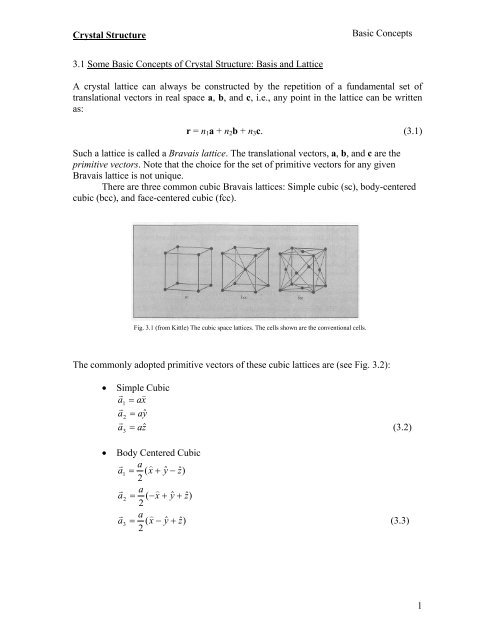
![arXiv:1303.7274v2 [physics.soc-ph] 27 Aug 2013 - Boston University ...](https://img.yumpu.com/51679664/1/190x245/arxiv13037274v2-physicssoc-ph-27-aug-2013-boston-university-.jpg?quality=85)
